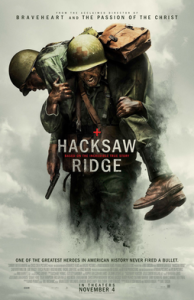Hacksaw Ridge
Posted on November 3, 2016 at 5:39 pm

Desmond Doss (Andrew Garfield) called himself a “conscientious supporter.” He wanted to support the troops fighting in WWII; he just would not touch a gun. And so, after brutal bullying and assaults and a court-martial, he was permitted to “go into battle without a gun.” And so, as a part of the “Liberty Battalion” of Army’s 77th Infantry Division, he went into one of the most dangerous battles of the war, with no weapons, just a Bible and some syringes with morphine.
Mel Gibson‘s first film as a director in a decade combines themes he returns to again and again: personal courage in the face of overwhelming odds, sacrifice for others, inspiration, faith, and very graphic, agonizing mortification of the flesh. The first half of the film introduces us to Doss, growing up in Lynchburg, Virginia with an abusive, alcoholic father (Hugo Weaving), falling for a pretty nurse (Teresa Palmer), and wanting to help the war effort without killing anyone.
Then there is an extended section covering basic training, with a tough but not humorless sergeant played by one of the few Americans in the cast, Vince Vaughn. It sweetly and sometimes amusingly harks back to the classic WWII films, with assorted characters from very different parts of the country are thrown together and a tough sergeant who whips them into shape with insults and threats, but everyone knows it is really for their own good, to teach them what they need to know to survive. There is no category for a regular army guy who says he cannot even touch a gun. They do everything they can to get him to change his mind or leave the military, but he will not give up. He’s a guy who will walk an extra two miles because he likes the woods. He knows who he is and what he believes.
And then, he is in battle. And again, he will not give up. “Just let me get one more, Lord,” is his prayer as over and over, 75 times, he heads back into enemy fire to pick up wounded men — including two Japanese soldiers — and carefully lower each one over a sheer cliff with an improvised pulley.
The scenes in battle are as harrowing as any ever put on screen. We are in the midst of utter carnage and chaos. Gibson knows how to create a visceral experience to make us understand just how extraordinary the rescue mission was. In an interview, he once said that he hates war, but loves warriors. Both are evident in this stirring tribute to a true hero.
Parents should know that this film includes extremely graphic and disturbing wartime violence with grisly images of wounded and dead soldiers, bullying and a brutal beating, domestic violence, and a car accident. Characters use some mild language.
Family discussion: How does the sergeant prepare the soldiers for war? How does he promote teamwork? What should the military do with “conscientious supporters?”
If you like this, try: “We Were Soldiers” and “Sergeant York”
